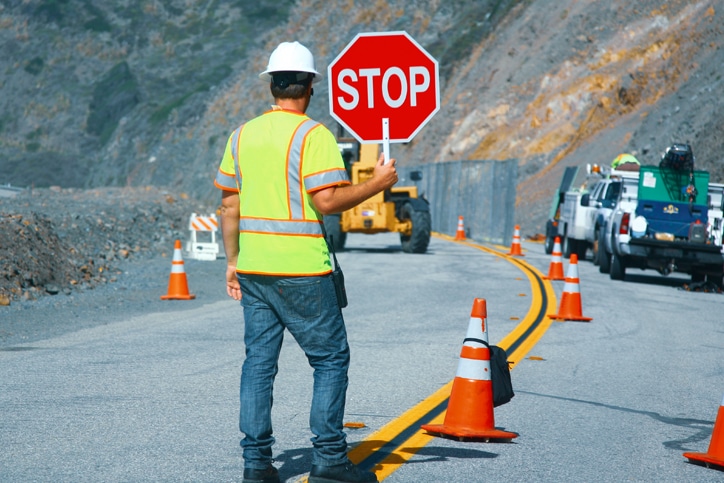It must be spring because orange traffic cones are popping up faster than tulips! As much as we love the return of warm weather, the new season also brings a fresh crop of potential workplace injuries. Road work, construction, landscaping, and other outdoor jobs come with unique hazards. However, by implementing some safety measures and proper training, employers and workers can help prevent potential injuries.
Common Hazards and Prevention Tips
Slips and Falls – According to the National Safety Council, slips, trips and falls rank as the third most common workplace injuries in any season, either indoors or outdoors, right behind exposure to harmful substances and overexertion. However, the number of these injuries tends to increase for people who work outside. Possible causes include uneven terrain, slippery surfaces, the use of ladders, and working on roofs, scaffolding or other elevated surfaces, just to name a few. To help prevent these types of injuries, employers and employees should:
- Keep walkways clear of obstructions, such as cables, equipment, and debris.
- Maintain even walkways and repair or replace damaged surfaces such as cracked pavement.
- Ensure proper drainage to prevent water from pooling and causing slippery conditions.
- Provide sufficient lighting if work is done at night or in low-light conditions.
- Clearly mark steps, gaps, ledges and other hazards.
- Make sure ladders and scaffolding are set up on stable surfaces and properly secured.
- Encourage employees to wear appropriate footwear with good traction and protective features, such as steel toes.
- Provide proper training on safety measures.
Cuts and Lacerations – Many outdoor jobs, such as landscaping, involve tools like shovels, rakes, pruners, chainsaws, lawn mower blades and other sharp objects. Cuts and lacerations (and even amputations) are common injuries, and because the equipment is often dirty, the risk of untreated cuts becoming infected is higher. If you suffer a cut or laceration, be sure to seek medical treatment as soon as possible. You can help prevent these injuries by:
- Wearing appropriate PPE, such as safety glasses, face shields, and gloves, along with proper footwear.
- Reading and adhering to instructions for the proper use of hand tools, power tools, and other equipment. Keep manuals handy for easy reference.
- Making sure power tools are not just off but unplugged from the power source before attempting to clean blades or make other repairs/adjustments. Never use your hands to clear clogs from lawnmowers, augers, and chippers/shredders!
- Avoiding the operation of any equipment if you are overly tired or feeling ill. Take regular breaks and stay hydrated.
- Keeping blades clean and sharp – blades are safer when sharpened because they help avoid having to apply excessive force during use and are less likely to jam or stick.
- Avoiding steep inclines when using mowers, especially ride-on mowers.
- Clearing excess debris, such as branches, limbs, and roots from the work area.
Electrocution – Spring brings storms, which in addition to dangerous lightning, often leave puddles and standing water. When combined with power tools or electrical cords, there is a possibility of electrocution. A single shorted wire can cause a worker to be electrocuted. To prevent these accidents, follow these tips:
- Keep electrical equipment dry and away from water.
- Use proper grounding and GFCI (ground fault circuit interrupters) protection.
- Inspect all electrical equipment, cords and outlets for damage or wear and tear, and replace any damaged items immediately.
- Require workers to wear proper personal protective equipment (PPE), like rubber gloves, insulated boots and non-conductive clothing.
- Ensure all workers are trained on electrical safety procedures.
- Halt outdoor jobs during storms with active lightning.
Traffic Accidents – Road crews risk being struck by moving vehicles, either by passing vehicles or construction vehicles. In fact, the Federal Highway Administration reports over 20,000 injuries and 100 fatalities annually at road construction sites. To help reduce those statistics, consider these preventive measures:
- Ensure all workers wear high-visibility clothing, hard hats, and other PPE.
- Develop and strictly follow traffic control plans.
- Make sure flaggers are properly trained and equipped with high-visibility clothing and appropriate signaling devices.
- Use the proper traffic control devices, such as barricades, cones and flashing lights.
- Channelize traffic to keep workers on foot out of areas where heavy equipment is in use.
- Provide training on safety measures.
Of course, there are many other potential risks involved in working outdoors, especially as temperatures rise in the summer months. Not only are these jobs essential, but many people prefer working outside in the fresh air and sunshine over being stuck behind a desk all day. According to a 2024 Occupational Requirements Survey, about 33% of American workers (nearly 50 million) are exposed to the outdoors to some degree. Stay safe out there!
What If You’re Injured?
Unfortunately, even with the best safety measures, many people still get injured on the job. If you suffer an injury at work the first thing you need to do (besides getting proper medical treatment!) is to notify your employer. To receive workers’ compensation benefits, you must, by NY law, notify your employer in writing within 30 days of the injury.
Secondly, you must file a claim (a Form C-3) for workers’ compensation benefits within two years of the injury. Depending on your injuries, you may be eligible for Social Security disability benefits, as well.
Rely on Our Experience
Filing a workers’ compensation or disability claim can be a complicated process, but we’re here to help. The Disability Guys are experienced in workers’ compensation law and are dedicated to helping injured workers receive the compensation they’re owed and getting their life back on track. For a free consultation to discuss your options, call (866) 205-2415.

